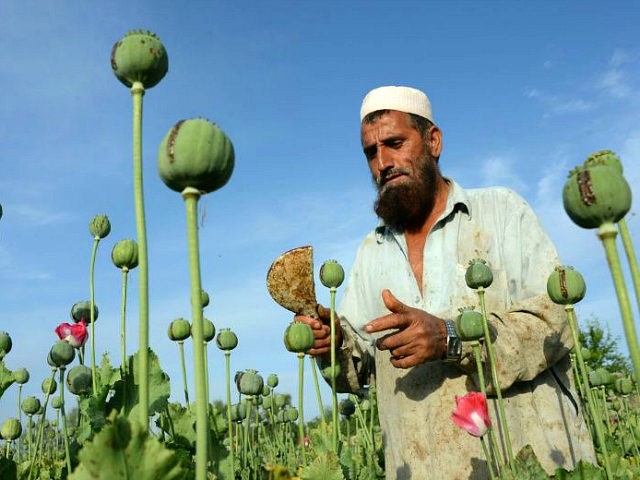U.S. President Donald Trump, while announcing on Monday his new strategy for dealing with the nearly 16-year-old war in Afghanistan, failed to explicitly address the historic levels of opium production there, a lucrative source of funding for the Taliban, the country’s leading terrorist organization.
According to U.S. Gen. John Nicholson, the top commander of American and NATO troops in Afghanistan, Taliban jihadists generate more than 60 percent of their funding from the cultivation and production of opium, the main ingredient in heroin.
Moreover, some officials have indicated that the illicit multi-billion-dollar poppy crop business in Afghanistan, the world’s top supplier of opium and heroin, is likely fueling the record number of deadly drug overdoses in the United States.
President Donald Trump has even declared a national emergency in response to the nearly 142 Americans killed each day by the opioid crisis gripping the United States, allowing the release of federal funds to help combat the alarming rate of overdose deaths and addiction.
He convened a bi-partisan commission in March to combat the abuse of deadly opioids in the United States, such as heroin, prescription painkiller medication, and the synthetic opioid fentanyl. So far, the commission has failed to acknowledge whether it believes Afghan opium production is linked to the heroin problem in the United States.
Opium cultivation in Afghanistan has skyrocketed in recent years alongside deadly heroin overdoses in the United States.
Citing Afghanistan’s Ministry of Counternarcotics (MCN), the Special Inspector General for Afghanistan Reconstruction (SIGAR), a U.S. watchdog agency, reported at the end of July that 2017 opium cultivation results “will likely exceed last year’s totals.”
The DEA reports that only one percent of seized heroin in the United States originates in Afghanistan, noting that the majority comes from Latin America.
Speaking to Breitbart News as a concerned citizen, John Sopko, the SIGAR chief, questioned the DEA figure, noting that the heroin epidemic in the U.S. has primarily affected states that border Canada, where the majority of heroin originates in Afghanistan.
Even if the DEA is right and only a small portion of Afghan heroin makes it into the United States, that amount has likely fueled at least one of the tens of thousands of deadly drug overdoses that take place each year.
Nevertheless, President Trump failed to mention the Afghan opium problem when announcing his strategy for dealing with the Afghanistan war on Monday.
The White House did not immediately respond to Breitbart News’s request for comment about what the Trump administration plans to do to combat the illegal opium business in Afghanistan.
Dr. Sebastian Gorka, who at the time was the deputy assistant to President Trump in the office of the chief strategist at the White House, told Breitbart News in late July that the administration is committed to fighting opium cultivation and production in Afghanistan.
The president’s team is revising America’s failed $8.6 billion counternarcotics strategy, something his predecessor postponed until the Trump administration took office, SIGAR has found.
In the first few months of the Trump administration, there has been an increase in interdiction and eradication activity after counternarcotics operations nearly disappeared under former President Barack Obama’s tenure.
However, it remains unclear if President Trump will keep his predecessor’s anti-opium policies, or lack thereof, in place.
Considered one of his first major Afghanistan war decisions soon after taking office in 2009, Obama oversaw the end of the main U.S.-led eradication effort, deciding, instead, to assist local and national law enforcement in carrying out their anti-drug operations.
The move resulted in record opium production and more funding for the Taliban.
Obama placed a much-needed revision to the failed U.S. counternarcotics strategy on hold for more than two years, postponing the approval of the revised plan until the Trump administration took office.
Trump’s team is apparently still in the process of crafting a revised plan.
In July, William Brownfield, the assistant secretary of State for the Bureau of International Narcotics and Law Enforcement Affairs (INL), met with Afghan President Ashraf Ghani to discuss the Trump administration’s plans to combat illicit narcotics at the regional and global level.
Brownfield revealed that “US President Donald Trump has a strong will in the fight against drugs and since Afghanistan is one of the biggest producers of drugs in the world, the strategy could have a positive impact on Afghanistan,” the Afghan president’s office noted in a statement. “Meanwhile Ghani has welcomed US strategy to fight against drugs.
Referring to jihadist groups in Afghanistan, Trump vowed during his speech that his administration would “maximize sanctions and other financial and law enforcement actions against these networks to eliminate their ability to export terror.”
The U.S. commander-in-chief defined victory in Afghanistan as “attacking our enemies, obliterating ISIS [the Islamic State], crushing al-Qaeda, preventing the Taliban from taking over Afghanistan, and stopping mass terror attacks against America before they emerge.”
Despite an estimated $8.6 billion in American taxpayer funds devoted to combating illegal narcotics in Afghanistan, opium cultivation and production continues to increase, and “Afghanistan remains the world’s largest opium producer and exporter—producing an estimated 80% of the world’s opium,” noted SIGAR.
On Monday, President Trump announced that he will escalate America’s involvement in the ongoing war in Afghanistan, which began in October 2001.

COMMENTS
Please let us know if you're having issues with commenting.